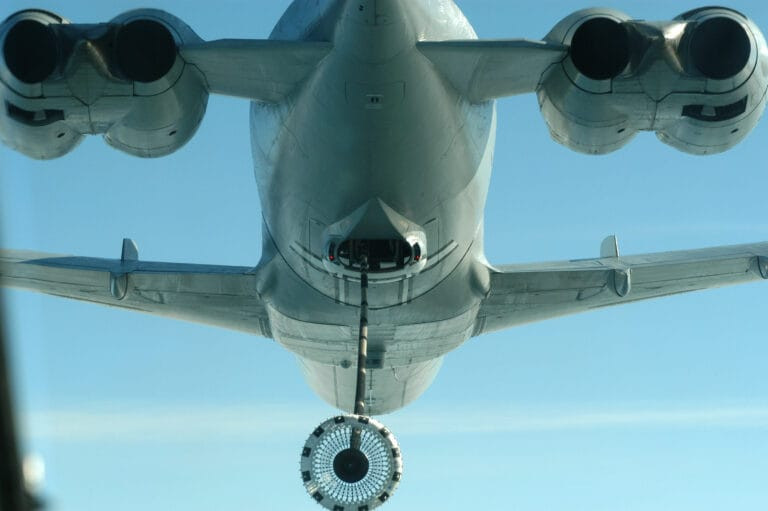Air-to-air refuelling (AAR) could revolutionise air cargo operations, offering potential fuel savings of up to 54 percent on long-haul routes while extending aircraft life, reducing engine wear, and increasing payload flexibility — applying a proven military concept to commercial efficiency.
Beyond cost and performance gains, AAR presents a major climate opportunity, complementing Sustainable Aviation Fuel and hydrogen by cutting emissions now, as aviation demand is set to double by 2044 amid growing pressure to decarbonise.
Safety and certification remain the biggest hurdles, but innovative reverse-role concepts — where the tanker operates behind the receiver — could make commercial AAR viable, with cargo carriers serving as the ideal testbed for large-scale adoption.
The Royal Air Force has long followed a simple maxim: “maximum payload, minimum fuel.” At first glance, it sounds counterintuitive—how can you fly with minimum fuel? The answer lies in Air-to-Air Refuelling (AAR). Military aircraft carry only enough fuel to reach the first tanker, where they top up mid-flight. This reduces weight at take-off, increases payload, and delivers faster, longer-range operations.
For the air cargo industry, the same logic could be transformative. If airlines could adopt a safe, commercially viable form of AAR, they might cut costs, extend aircraft life, and take a serious step toward meeting sustainability targets.
Imagine two identical widebody aircraft taking off from Heathrow, each with the same payload but different fuel strategies. One is military, one civilian.
Research by Dr Raj Nangia shows that, on a 9,000-nautical mile route, the military aircraft—refuelled three times in flight—burns 60 percent less fuel than the civilian one. Even after accounting for the fuel used by the tankers, the saving comes to 54 percent. For any carrier, that’s a massive operating cost reduction.
The logic is simple. Why carry tonnes of fuel for the entire journey when you could refuel en route? Motorists understand this instinctively—you don’t drive a car with a roof tank full of petrol “just in case.”
Beyond fuel savings
Beyond fuel savings, the advantages of air-to-air refuelling stretch into every corner of aircraft performance and operations. An aircraft minimising landings and take-offs through AAR undergoes fewer pressurisation cycles, easing structural stress and therefore extending overall airframe life. Engines aren’t forced to work at maximum thrust so often, which reduces wear, while tyres and landing gear also benefit from proportionately fewer landings.
Lower take-off weights give airlines greater operational flexibility, making it possible to serve airports with shorter runways and enabling more direct, point-to-point routes. Lighter departures also help counteract reduced lift in hotter conditions, an increasingly important factor as global temperatures climb.
As Dr. Nangia highlights, the payload-to-maximum take-off weight ratio of a refuelled aircraft is nearly double that of a conventional long-range aircraft—proof that the efficiency gains are built into the physics itself.
A climate imperative
AAR is hardly new—the military has used it for over 80 years. But the urgency of climate change makes its potential commercial application worth revisiting.
Sustainable Aviation Fuel (SAF) has been heralded as the industry’s silver bullet, yet the reality looks more limited. Research published in August 2025 suggests SAF may deliver less than a 50 percent reduction in climate warming impact compared to Jet A. Supply constraints and political headwinds—particularly in the US—will limit its scale.
Meanwhile, the Grantham Institute at Imperial College recently linked climate change to tripling the number of heat-related deaths in London during the June–July 2025 heatwave. Aviation may not be the largest contributor to warming today, but its share will grow as global demand rises. Airbus forecasts an extra 10 trillion Revenue Passenger Kilometres by 2044—doubling traffic in less than 20 years. If radiative forcings are fully counted, aviation’s contribution is already higher than official figures suggest.
Making it work for civil aviation
The main challenge for commercial air-to-air refuelling lies in safety and certification. Traditional military methods, such as the probe-and-drogue or flying boom systems, require the receiver aircraft to fly just 50–70 feet behind the tanker, navigating turbulent air with extreme precision—a level of manoeuvring that would be impractical and unsafe for commercial operations.
One potential solution is to reverse the roles: the tanker would remain behind the receiver, managing the entire refuelling process much like ground crews handle traditional fuelling. In this approach, the receiver deploys a lightweight cable on a motorised drum, equipped with a steerable drogue. The tanker crew then remotely guides the drogue to connect with a probe on their fuel hose, after which the receiver reels in the hose to link with its fuel inlet.
Once the connection is secure, the tanker can safely increase separation by extending additional hose, achieving the distance required for certification. This setup keeps the technical complexity and training requirements with the specialist tanker crews, rather than burdening commercial pilots, offering a viable path toward safe, efficient in-flight refuelling.
A place to start
Is this the ultimate solution? Perhaps not. Yet the potential cost savings, efficiency gains, and climate benefits are simply too significant to overlook. If air-to-air refuelling is ever to be tested commercially, cargo flights offer the most logical proving ground. The sector already values payload flexibility, faces fewer complexities around passenger safety, and operates on tighter margins where efficiency improvements have an immediate impact. While AAR may never replace Sustainable Aviation Fuel or hydrogen, it could serve as a powerful complement—buying the industry time while cutting emissions at scale as longer-term solutions mature.
Aviation faces a stark reality: demand is poised to soar just as climate impacts become increasingly severe. Meeting this challenge cannot rely on incremental improvements or unproven fuels alone. Sometimes the answers lie in ideas we’ve had all along, waiting to be applied in a new way. Perhaps now is precisely the moment to ask whether the principle of “maximum payload, minimum fuel” should guide not only fighter jets, but cargo holds as well.





